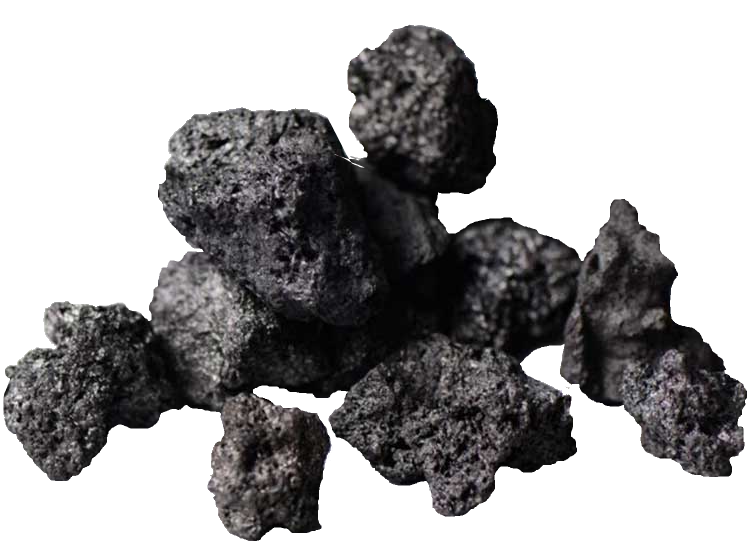calcined petroleum coke

INTRODUCTION
Petroleum coke, or petcoke, is a product produced from crude oil, derives from the final cracking process, that takes place in a unit called delayed coker unit during the oil refining process. Petroleum coke is a process that involves steps such as thermal decomposition, polymerization and condensation .Petroleum coke are in two main different forms: as raw form or green petcoke , ( GPC) and calcined petcoke (CPC) . The principal difference is the amount of residual hydrocarbon (also termed volatile matter) in the two products.

Petroleum cokes are produced at refineries using three different types of coking processes: delayed, hid, and flexi coking. The delayed coker is mostly used at refineries processing . Coke products from a delayed coker are classified as shot, sponge, (sometimes honeycomb), or needle coke depending on their chemical and physical characteristics. Shot coke ,almost always sold as fuel, is hard, having spherical form, and physically produced through precipitating asphaltenes. sponge coke (mostly used for anode-grade) is dull and black, having porous, amorphous structure, and is considered as a mixture of shot and needle cokes; and needle coke (not used in anode production) is silver-gray, having crystalline broken needle structure. Also Based on the quantity of Sulphur it contains (which can vary from 0.5% to 8.0%), we can divide petcoke into three main categories: low Sulphur, medium Sulphur and high Sulphur.
Green Coke :
Green coke is the initial product from the cracking and carbonization of the feedstock’s to produce a substance with a high carbon-to-hydrogen ratio. As its heating value is higher than coal’s, it can be used as a heating material in electricity generation and in cement kilns. Fuel grade petcoke produces no visible ash when burned. it is an extremely stable fuel which means there is little risk of combustion during transportation.Green coke undergoes additional thermal processing to produce calcined coke. The additional processing removes volatile matter and increases the percentage of elemental carbon, which results in a lower potential for toxicity for calcined coke.
Calcined Petroleum Coke ( CPC) :
CPC links the oil and the metallurgical industries as it provides a source of carbon for various metallurgical applications including the manufacture of anodes for the aluminum pot liners and for graphite electrodes. CPC can be created using a number of processes , including rotary kiln, hearth and vertical shaft technologies but the main process is rotary kiln. Petroleum coke calcining is a three step process, including drying, devolatization and densification. The coke calcining process is a time-temperature function, conducted in an oxygen deficient atmosphere . In rotary kiln process, calcinations of coke are usually done at about 1300°C to 1500°C. During the process the coke is further decomposed, increasing in the carbon to hydrogen ratio from 20 of green coke to 1000 for calcined coke and residual moisture will be driven off . Along with increasing in the fixed carbon of the coke , electrical conductivity improved and real density increase when coke is calcined. Sulfur content of the calcined coke is dependent on the sulfur in the green coke as feed of process. Typically, since low sulfur content is usually required for calcined product, only low sulfur green cokes are calcined.
Application:
Aluminum: The majority of calcined petroleum coke finds its way into the primary aluminum industry .Calcined petcoke is necessary to make anodes for smelting and is the only commercially viable method to do so. It boasts a superior combination of electrical conductivity and resistance to chemical and physical degradation in the smelting pot, which contains lower levels of contaminants (i.e. ash).
Paint and Colorings: Calcined petcoke is used in the production of titanium dioxide (TiO2 ), a mineral that is used as a substitute for lead in paint. TiO2 is also used as a pigment in sunscreen, plastic and food coloring
Steel: Calcined petcoke is a partial replacement for metallurgical coal as a feedstock for coke oven batteries, and as a partial substitute for pulverized coal directly injected into blast furnaces. Petcoke that is specially produced to have a needle-like crystal structure is called needle coke. Needle coke is used to produce the electrodes used in electric arc furnace (EAF) steel production.
Brick and Glass: Calcined petcoke is used by brick and glass manufacturers because it has a significantly lower ash content compared to other fuels.
Paper: Calcined petcoke is gasified to produce ammonia and urea ammonium nitrate, which is then to produce pulp and paper. The TiO2 that is produced from calcined petcoke is also used as a mineral that is then used as a whitener for paper.
Fertilizer: Calcined petcoke is gasified to produce ammonia and urea ammonium nitrate, which is then used in fertilizer production.
if you have any question about product detail please
MARKETING POLE GROUP
Central Office TEL: 0098 5138407354
Email : info@marketingpole.com